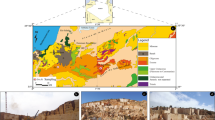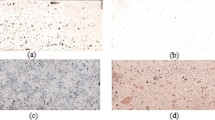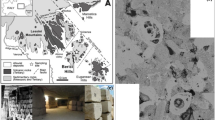Abstract
The frost weathering of three French limestones [Lens (LS), Migné (MI) and Savonnières (SA)], with different physico-mechanical properties, during the freeze–thaw cycles was studied. The weathering evolution in stone samples undergoing the freeze–thaw cycles was monitored by measurement of following properties: total porosity, P-wave velocity, static elastic moduli, uniaxial compressive strength and toughness. The thermo-mechanical behaviour of stones was also studied by measurement of the strain and temperature (in surface and centre of sample) during one freeze–thaw cycle. These results, mainly the weathering observed for SA(73) with a degree of saturation of 73 % and a lack of weathering for LS with a degree of saturation of 90 %, show that it is impossible to define a unique critical degree of saturation for different stones and this varies from stone to stone. The shrinkage and (or) the expansion of samples during the crystallization phase were determined. The shrinkage is related to the migration of water away from tiny pores towards larger cavities where ice has already formed. The expansion is attributed on the one hand to the rise in pressure that comes from the water which flows towards the ice front and on the other hand to the relatively important quantity of ice formed when thermal contraction and the contraction due to migration dominate. The elastic moduli (static moduli and dynamic moduli) was found to be affected the most by frost weathering and is a real sensor of first micro-crack initiation, whereas the uniaxial compressive strength and the porosity were found to be affected the least.








Similar content being viewed by others
References
Allison RJ (1988) A non-destructive method of determining rock strength. Earth Surf Proc Land 13:729–736
Alomari A, Brunetaud X, Beck K, Al-Mukhtar M (2013) Experimental study on the role of freezing-thawing in the degradation of stones in the Castle of Chambord. In: Built Heritage Monitoring Conservation Management
Bellanger M, Homand F, Remy JM (1993) Water behaviour in limestones as a function of pores structure: application to frost resistance of some Lorraine limestones. Eng Geol 36(1993):99–108
Chen TC, Yeung MR, Mori N (2004) Effect of water saturation on deterioration of welded tuff due to freeze-thaw action. Cold Reg Sci Technol 38:127–136
Cooks J (1983) Geomorphic response to rock strength and elasticity. Zeitschrift für Geomorphologie 27:483–493
De Witte E, Vergès Belmin V, De Clercq H, Van Hees R, Miquel A, Bromblet P, Brocken H, Cardani G, Tedeschi C, Binda L, Baronio G, Lubelli B, Garavaglia E (2001) Salt Compatibility of Surface Treatments (SCOST): Final Report. European Contract ENV4-CT98-0710. Brussels: KIK-IRPA
Dessandier D, Auger P, Haas H, Hugues G (2000) Guide méthodologique de sélection des pierres des monuments en termes de durabilité et compatibilité. BRGM/RP-50137-FR
Eslami J, Grgic D, Hoxha D (2010) Estimation of the damage of a porous limestone from continuous (P- and S-) wave velocity measurements under uniaxial loading and different hydrous conditions. Geophys J Int 183(3):1362–1375
Everett DH (1961) The thermodynamics of frost damage to porous solids. Trans Faraday Soc 57:1541–1551
Fagerlund G (1993) Frost resistance of high performance concrete - Some theoretical Considerations. Lund Institute of Technology, Division of Building Materials, Report TVBM-3056, Lund
Hamès V, Lautridou JP, Ozer A, Pissart A (1987) Variations dilatométriques de roches soumises à des cycles “humidification-séchage”. Géogr Phys Quat 41:345–354
Hirschwald J (1908) Die Prüfung der Natürlichen Bausteine auf Ihre Wetterbestandigkeit. Verlag von Wilhelm Ernst & Sohn, Berlin, p 675
Letavernier G (1984) La gélivité des roches calcaires, relation avec la morphologie du milieu poreux. Thèse de troisième cycle, Mention Géographie, Caen
Litvan GG (1978) Freeze–Thaw durability of porous building materials, in Durability of building materials and components. Special Technical Publication STP 691. American Society for Testing and Materials, p 455–463
Marco Castaño LD, Martínez-Martínez J, Benavente D, García-del-Cura MA (2010) Failures in the standard characterization of carbonate dimension stone durability during freeze-thaw testing. Global Stone Congress
NF EN 12371 (2010) Natural stone test methods—determination of frost resistance
NF EN 14579 (2005) Natural stone test methods—determination of sound speed propagation
NF EN 1926 (2007) Natural stone test methods—determination of uniaxial compressive strength
NF EN 1936 (2007) Natural stone test methods—determination of real density and apparent density, and total and open porosity
NF B 10-504 (1973) Quarry products—limestone—measuring he water absorption coefficient
Pissart A, Lautridou J-P (1984) Variations de longueur de cylindres de pierre de Caen (calcaire bathonien) sous l’effet de séchage et d’humidification. Z Geomorphol Suppl 49:111–116
Powers TC, Helmuth RA (1953) Theory of volume changes in hardened Portland cement paste during freezing. Proceedings of the Highway Rese. Board, N°32, p. 285–297
Prick A (1995) Dilatometrical behaviour of porous calcareous rock samples subjected to freeze-thaw cycles. Catena 25:7–20
Prick A (1997) Critical degree of saturation as a threshold moisture level in frost weathering of limestones. Permafrost Periglac Proc 8:91–99
Ruedrich J, Kirchner D, Siegesmund S (2011) Physical weathering of building stones induced by freeze–thaw action: a laboratory long-term study. Environ Earth Sci 63:1573–1586
Saad A, Guédon S, Martineau F (2010) Microstructural weathering of sedimentary rocks by freeze–thaw cycles: experimental study of state and transfer parameters. C R Geosci 342:197–203
Stockhausen N (1981) Die Dilatation hochporöser Festkörper bei Wasseraufnahme und Eisbildung. PhD, TU München, p 163
Tan X, Chen W, Yang J, Cao J (2011) Laboratory investigations on the mechanical properties degradation of granite under freeze–thaw cycles. Cold Reg Sci Technol 68:130–138
Tourenq C (1970) La gélivité des roches, application aux granulats. Rapport de Recherche N°6 LCPC
Tutluoglu L, Keles C (2011) Mode I fracture toughness determination with straight notched disk bending method. Int J Rock Mech Min Sci 48:1248–1261
Vlahou I, Worster MG (2010) Ice growth in a spherical cavity of a porous medium. J Glaciol 56(196):271–277
Acknowledgments
This research was carried out thanks to subsidies from the “Fondation des sciences du Patrimoine, Labex PATRIMA” and to Rocamat and France Pierre. The authors express their gratitude to these organizations.
Author information
Authors and Affiliations
Corresponding author
Rights and permissions
About this article
Cite this article
Walbert, C., Eslami, J., Beaucour, AL. et al. Evolution of the mechanical behaviour of limestone subjected to freeze–thaw cycles. Environ Earth Sci 74, 6339–6351 (2015). https://doi.org/10.1007/s12665-015-4658-2
Received:
Accepted:
Published:
Issue Date:
DOI: https://doi.org/10.1007/s12665-015-4658-2




